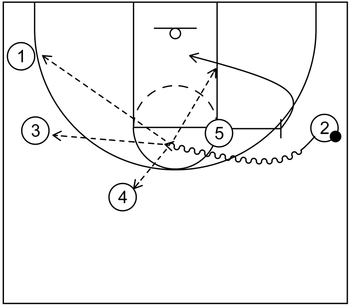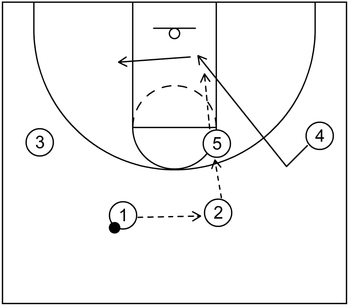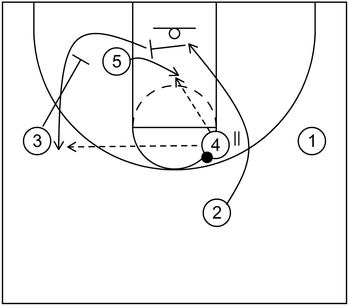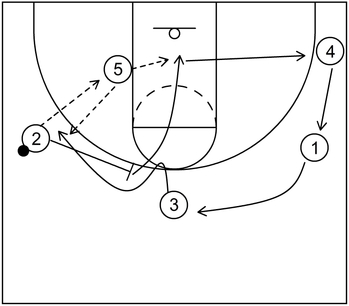What is the UCLA offense in basketball
The UCLA offense is a basketball offensive strategy developed by Coach John Wooden that focuses on the fundamentals of passing, screening, and cutting to create various scoring opportunities, primarily near the basket but also near the perimeter as well.
Furthermore, the UCLA offense emphasizes a type of basketball cut known as the UCLA cut which occurs when a player cuts to the basket by way of a back screen set by a high post player.
In addition to that, the UCLA offense also features scoring options by way of the high post as well as high low actions. The high post action of the UCLA offense could be beneficial for undersized basketball teams or other types of guard-oriented teams in general.
This action occurs when a high post player receives the ball from a perimeter player, and from that point, different scoring options could develop via offensive sequences such as backdoor cuts or basketball screens.
On the other hand, the high low action could be favorable to teams that have low post players with size and skill but a potential downside is that there would be less cutting to the basket.
The high low action occurs when a low post player receives the ball from a high post player. Afterwards, the low post player would attempt to score near the basket.
What are general principles of the UCLA offense
Good spacing
Players should emphasize good spacing which is about 12 to 15 feet apart. Also, players can fill the slots, the wings, the high post areas, or the low post areas.
If players execute bad spacing by not being in the right spots, then it could become much more difficult to score efficiently and effectively within the UCLA offense.
Good passing
Players should emphasize passing as opposed to dribbling when executing the UCLA offense. Offensive teams that are able to pass the ball quickly and with purpose will typically have a greater chance to break down the defense, which in turn, could lead to high percentage shots.
Also, if a player on the wing or a player in the high post receives the ball, then this will usually open up a cutting lane to the basket for scoring possibilities.
Adaptability
Players do not have to always follow set patterns when executing the UCLA offense. For example, if the offensive team would like to execute a slot to wing pass but the defense takes that option away, then the offensive team could counter that defensive sequence with something such as a backdoor cut or high post action.
What are simple examples of the UCLA cut within the UCLA offense
Example 1 – Part 1

This is an example of a quick hitting set which features the UCLA cut and side ball screen action for scoring opportunities within the UCLA Offense. To begin, 2 receives the ball from 1 and following that, 1 executes the UCLA cut to the basket via the back screen set by 5.
After that, 1 could receive the ball from 2 if that is open. On the other hand, if 1 is not open, then 1 could continue the cut through to the left side corner.
Example 1 – Part 2

Next, 2 dribbles toward the middle of the court near the free throw area via the side ball screen set by 5 who also rolls to the basket. From that point, 2 could take the mid-range jump shot if open or pass to other teammates for additional scoring possibilities.
Example 2 – Part 1

This is an example of a quick hitting set play which features dribble entry action and the UCLA cut with multiple scoring options.
To start, 1 dribbles toward the right side wing and following that, 3 cuts to the left side low post block. Also, 2 cuts across to fill and replace at the right side slot area.
Example 2 – Part 2

Next, 2 executes the UCLA cut towards the basket via the back screen of 5 and could receive the ball from 1 if that is open. If it is not open, then 2 could continue out towards the right side corner while 5 receives the ball from 1 instead.
After that, 3 cuts to the left side wing via the down screen set by 4, receives the ball from 5, and takes the three-point jump shot if open.
Also, as an alternative option, 4 could slip to the basket after setting the down screen and receive the ball from 5 for another scoring option.
What is an example of basic high post action within the UCLA offense
Part 1

This is an example of a basic high post set within the UCLA Offense which includes a backdoor cut, back screen, and a handoff. To start, 2 receives the ball from 1 and following that, 5 receives the ball from 2.
Next, 4 backdoor cuts to the basket and could receive the ball from 5 if that is open. If 4 is not open, then 4 continues the cut towards the left side low post block.
Part 2

Following that, 3 cuts to the basket via the back screen set by 4, receives the ball from 5, and could score at the basket if open.
If 3 is not open, then 3 could continue the cut out towards the right side corner. Also, 4 could fill the left side wing after setting the screen.
Part 3

Next, 2 cuts to the basket, receives the handoff from 5, and then scores at the basket. If 2 is not open to receive the handoff, then 1 cuts to the wing via the flare screen set by 4, receives the ball from 5 and takes the open jump shot.
Also, as an alternative option, 3 could receive the ball from 5 for another jump shot option if the defender of 3 decides to help one pass away when 2 cuts to the basket.
What are examples of high low actions within the UCLA offense
Example 1 – Part 1

This is an example of basic high low action which also includes a backdoor cut, handoff and basketball screens for different scoring options. To begin, 1 dribbles towards the right side wing which signals 4 to backdoor cut to the basket.
At that point, 4 could receive the ball from 1 and score near the basket if that is open. If it is not open, then 4 could cut back down to the right side high post area and receive the ball from 1.
Example 1 – Part 2

Next, 2 could cut to the basket, receive the handoff from 4, and score at the rim. If 4 cannot deliver the handoff, then 5 could cut into the lane via the cross screen set by 2.
After that, 5 could receive the high low pass from 4 and score near the basket with a low post move.
Also, if 5 cannot receive the ball, then 2 could continue to the left side wing via screen the screener action set by 3. From that point, 2 could receive the ball from 4 and take the three-point jump shot if open.
Example 2 – Part 1

This is an example of basic high low action within the UCLA offense to create scoring opportunities near the basket. To start, 2 receives the ball from 1 and afterwards, 3 receives the ball from 2.
Following that, 2 executes a UCLA cut to the basket via the back screen of 5, receives the ball from 3, and then scores at the basket if that is open.
If 2 is not open to receive the ball, then 2 continues the cut out towards the left side corner. At the same time, 4 cuts down to the left side low post block while 1 cuts to the middle of the court for defensive balance.
Example 2 – Part 2

Next, 4 cuts to the right side high post via the screen set by 5 and receives the ball from 3. After that, 5 quickly executes a pivot turn to receive the high low pass from 4. From that point, 5 could score with a low post move such as a hook shot.
What is an example of 1-4 high action within the UCLA offense
Part 1

This is an example of the UCLA cut as well as flex action from a 1-4 high set. To start, 2 receives the ball from 1 and after that, 1 executes the UCLA cut to the basket.
Following that, 1 could receive the ball from 2 and score at the rim. If 1 is not open, then 1 could continue the cut towards the left side low post block.
Part 2

Next, 3 executes a flex cut via the flex screen set by 1, receives the ball from 2, and then scores with a layup or dunk. Also, as a secondary option or if 3 is not open, 1 cuts back to the top via the stagger screens set by 4 and 5.
After the screen the screener action, 1 receives the ball from 2 and takes the open three-point jump shot.
Affiliate Disclosure: I may earn a commission on qualifying purchases made through the links below.
What is an example of an offensive set play that uses the UCLA cut
Part 1

This is an example of a Horns offensive set play that uses the UCLA cut for scoring opportunities. It is derived from Loop and Elbow Offenses and Counter Sets by Cheryl Reeve.
To begin, 1 executes a dribble entry towards the right side wing. When that occurs, 2 executes a zipper cut to the top via the pin down screen set by 4.
After that, 2 receives the ball from 1 while 4 self replaces at the right side high post elbow. Also, as that action occurs, 3 utilizes a V-cut to get open near the left side wing area.
Part 2

Next, 2 dribbles toward the left slot area and following that, 3 receives the ball from 2. Afterwards, 2 executes a UCLA cut to the basket via the UCLA screen set by 5.
From there, 2 could receive the ball from 3 and score at the rim if that is open. Conversely, if 2 is not open, then 2 could cut to the left side low post area while 1 drifts to the empty right side corner.
Part 3

Next, 3 dribbles toward the middle of the court via the ball screen set by 5. Furthermore, after the ball screen action occurs, 2 cuts to the previously occupied left side wing area via a down screen set by 5.
At the same time, 1 cuts to the right side wing area via a wide pin down screen set by 4. After that, 1 could receive the ball from 3 and take the open jump shot or 2 could receive the ball instead and take the open jump shot as well.
Also, if 2 receives the ball but does not take the jump shot, then 4 could fill the vacant right side corner.
Part 4

From that point, 5 could receive the ball from 2 and after that, the post split action could occur. Therefore, 3 could cut to the left side wing via an away screen set by 2.
Furthermore, 2 could slip the screen and cut to the basket as well. Afterwards, 3 could receive the ball from 5 and take the open jump shot. Alternatively, 2 could receive it instead and score at the rim.
On the other hand, if 5 decides to score with a low post move, then 2 could fill the right side corner while 4 fills the right side wing and 1 fills the top to create floor balance.